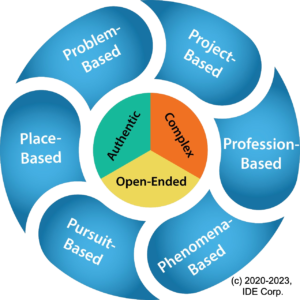revised 11/26/23
We all learn best when we are motivated to learn, and the intrinsic motivation of interest, pride, and “felt need” works much better than the extrinsic motivation of rewards, peer pressure, and fear! How do you build an intrinsic motivation to learn? Anchor the learning to some bigger problem or challenge that motivates students to want to learn! Throughout instruction and learning activities, keep going back to that anchor, with students edging closer and closer to solving the problem or tackling the challenge.
For example . . . Do you think you could convince your favorite living author to write a book about our city or town? This can be as simple as sharing that anchor with the students at the start of a reading unit focusing on character, plot, and setting. It could be as robust as having students actually try it and send their letters and videos off to the authors. Whichever route you choose, the key is to keep returning to it as the learning continues. In this example, after you delve into setting, you can ask students, “Given the settings your favorite author often uses, and knowing the physical setting of our town, what points will you make to convince your author that our setting is just right for a next book?” (See my blog post, “In Search of the Perfect Problem.”)

The anchor keeps students focused on a larger outcome to their learning, and one that is connected to the real world, which increases motivation whether students are at home or in school. I’ve heard from teachers whose students asked on an upcoming snow day if they would be online, since the students were planning to continue working on their problem from home. I’ve had teachers share that students come in to school having researched considerably the night before, excited to share their findings. Problems and challenges motivate! Consider IDE’s “6 Ps of PBL” — six different types of PBL anchors to share with students at the launch of a unit of study:
- Problem-Based Learning — An open-ended, real-world problem to solve. Examples: Ending racism, having an impact on the global water shortage, saving a species from extinction, or developing a product to help the disabled.
- Project-Based Learning — An open-ended, real-world challenge to tackle. Examples: Creating a plan for a sustainable, vertical garden; creating a better way to design the “March Madness” brackets; creating an original piece of art for a specific purpose; or making a gift for that special “mom” in your life.
- Place-Based Learning — An open-ended, real-world problem or challenge that is specific to a location, which could be the classroom, home, local community, town or city, state, country, continent, world, or outer space! Examples: Redesigning the classroom to make the best use of space, designing a self-supporting ecosystem in a biodome that could enable life on Mars, developing a plan for welcoming new students to the school, or developing a dream vacation to a specific location.
- Profession-Based Learning — An open-ended, real-world problem or challenge that is specific to an existing or future career option. Examples: Developing a portfolio to become a Disney Imagineer, designing a new clothing line, developing nutritious and tasty recipes for 3-D food printers, or developing the plans to renovate a house.
- Phenomena-Based Learning — An open-ended problem or challenge based on scientific phenomena. Example: The Uyuni salt flat is a phenomenon left by the drying of prehistoric lakes; it is home to most of the world’s lithium. While critical to the economy of Bolivia because of its resources and tourism attraction, it is a fragile ecosystem. How can we anticipate the threats to this ecosystem and address them in advance?
- Pursuit-Based Learning — A problem or challenge that is identified by the student based on a personal interest they wish to pursue. The options may be narrowed to the curriculum or, if broader, the teacher would help the student see how the curriculum could fit into the problem or challenge.
You don’t have to delve into it as extensively as is done in the above links, with a task statement and rubric. You can simply launch a unit of study by presenting a problem or challenge for students to ponder throughout the unit.
As students are engaged in lessons and instructional activities, have them continually return to the PBL anchor and answer the question, “How will this help me solve the problem/tackle the challenge?”
Anchoring learning is an important aspect of creating an atmosphere (overall feeling) of continual motivation, one of the seven attributes of a hybrid learning environment.
For More:
Join a Virtual Learning Community on PBL or Designing Hybrid Learning Environments: www.edquiddity.com/VLC
Build a Culture of Professional Learning by engaging an entire school in our online, on-demand, professional learning experience on PBL!
